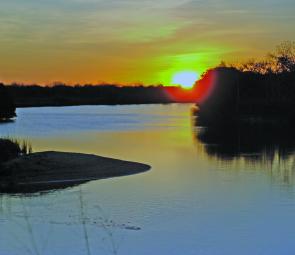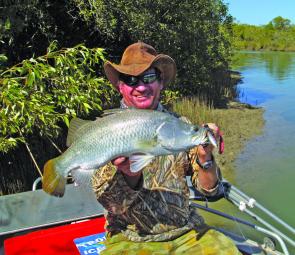You often hear anglers debating about the virtues of trolling verses casting in tropical creeks. One area that casting reigns supreme is when the plan is to fish from the bank, a very successful method that is not often used.
Bankside fishing lets you get in where your boat can’t, such as around the rocky headlands, and a bank can generally accommodate a lot more anglers than boat based casting does. It also allows for different retrieve and casting angles; in essence creating a new set of targets to fish.
The three most common locations to cast from are road crossings, tight bends in creeks, and rocky headlands and beach rocks.
These three locations can be approached in a number of ways, but you should always endeavour to fish with a purpose. By this I mean target something such as a bankside snag on a tight river bend, a funnel of water through rocks that create eddies on a road crossing or a rocky point or outcropping on the beaches and headlands. While you can catch barra over barren areas, they are generally fish cruising to a better location. Those found around structure are there for a reason, and that reason is usually food and shelter.
In the hardbodied corner I like shallow running lures and topwater lures for bankside casting. The reason is that they catch fish and are less likely to snag up. If I can avoid losing a lure and avoid having to try and retrieve it - especially in croc country - while still catching a fish, then the lure style has my vote.
After fishing an area for a while I’ll try a deep diver if the shallow and topwater presentations haven’t proved productive.
My first choice in deep diver is a semi-suspending Richo Extracta; a marvellous Australian-made lure that is a barra magnet. Another option is the American derived, deep diving, fat bodied plug lure. I find that the American lures are reliably good for casting and they certainly have appeal to our tropical sportfish, not just barra. An alternative is a weedless rigged soft plastic that can be literally thrown into the heaviest cover and worked out of mess you’d never throw a treble armed lure into.
A lot of boat-based fishing focuses on snags, such as trees and the like that have fallen in the water or mangroves and are surrounded by water on a flood tide.
With bankside fishing I look for rocks, sandbanks and deep holes. You’ll often find a variety of these along a productive stretch of bank and half-a-dozen or more anglers can get out, stretch their legs and fish without bumping into each other. Basing yourself on the outside of a bend puts the deep water at your feet; as well you get more bank area to spread out. Excitingly, the fish can strike at your feet, in the vicinity of structure or baitfish, or from the edge of the sandbank where it shelves off into the deeper holes.
I like the jerk and pause type techniques in one of the following three scenarios:
1/ Dave Donald taught me to jerkbait shallow running lures like Gold Bombers, Halco Lasers and Norman Razors, around the “open water” rocks on the beaches and headlands.
2/ The best barra casting in a creek that I’ve had was a few years ago in a rainy Hinchinbrook. One area that casting reigns supreme is when the plan is to fish the bank.
Autumn was where we walked the dog with topwaters like the Reaction Innovations Vixen and a variety of wooden homemade specials.
3/ The weirdest barra session that I’ve ever had was winding deep divers down deep until they bumped into the sandbank drop-off. Once the lure hit the bank we’d stop winding the reel handles and try to hold the lure against the face of the bank for a moment. Then when we put a bit of slack in the line to let the lure either suspend or float slightly upwards, the barra would be behind it and they’d inhale. This session was weird because, even though the fish were swimming around through all of the water, they only bothered to eat when the lures had pinned themselves against the sand. I assume that the fish were so shut down that they wouldn’t expend any energy to chase food, so they only took the ‘can’t miss’ option.
Anglers who are spread out along a bank seldom carry a net or even a gaff when walking the shores – unless they must in the case of locations where fish are hard to land or light line is in use. Nets are just too awkward to carry and gaffs aren’t so popular these days. But nearly everyone will carry a Boga Grip.
These days, anglers are most likely to swim a barra up the bank or into the shallows. If you intend to release a fish then any technique that reduces the lifting of the larger fish is preferred; hence the option of swimming and leading a fish out of the water. Once encouraged up the bank, the angler gets out their trusty (and sometimes rusty) set of pliers with which to remove the hook. With the use of heavier lines and heavier leaders, fish can be dragged and steered, thus reducing the need for hands to go near the lower jaw - and the lure’s trebles - for lip gripping.
Speaking of lip gripping, the introduction of the Boga Grip has forever improved bankside fishing. Boga Grips allow anglers to safely land the fish by keeping the lure’s hooks away from your soft fleshy hands and forearms. However I recently heard of an incident where the biggest fish of a trip and the gun lure were lost when a cheap imitation lip grip broke, well actually, the handle parted company from the tool’s mechanical jaws. Stick to the real deal.
Even in the boat when a net is used many crews use a Boga Grip to remove the fish from the net and to hold the barra’s head safely when the lure is being removed by a set of long nosed pliers.
To avoid the croc factor and to look after the tasty fillets, fish are commonly taken back to the boat and dispatched into the ice slurry. Remember if you are going to use your boat to get back to the car/trailer then check the regulations about fillets (the tip here is not to break your fillets down into meal sized pieces until you get home – they must remain connected by a skin flap at least)
To avoid crocs I certainly won’t stand in muddy water and from a muddy bank in order to fish. Normally I’ll try to stand on the rocks with clear water around or on a high sandy bank. There is no way to 100% protect yourself; I will say that some of my reflections on nearly 20 years of barra fishing, including many fish caught from the bank, are from a time long ago when to see a croc on a river was an experience worthy of making comment. However these days, locations that you once may have only seen one croc, are now likely to show a dozen or more prehistoric critters.
I once had a croc park itself between me and the boat; one launched off a high bank above and into the water. Another time, a croc was hidden in a little gully half full of water at the top of a bank; when it burst out I thought I was dead meat –fair dinkum croc bait.
If you must fish from a muddy bank in muddy water, then park the boat and cast from the boat.
For anglers who cast and troll, then a lighter baitcaster outfit, spooled with 30lb braid, often serves the dual role of both casting or trolling.
Reads: 3140
In the very foreground of the photo a surface lure waddles across the surface from shallow water to deep water; the deeper water on the outside of the bend is a barra goldmine.

working the outside bend of a creek from the bank, particularly if there is a Y junction nearby, means that a couple of boat loads of anglers can all fish at the same time.

If you must fish from a muddy bank in muddy water, then park the boat and cast from the boat.

These three lures cover the hardbodied options pretty well for bankside casting where casting distance is a high priority;

Use the real Boga Grip –this imitation set cost the biggest fish of the trip.





